12 Best Biodiversity Impact Reporting Tools for 2025
Karel Maly
October 8, 2025
As regulatory frameworks like the Corporate Sustainability Reporting Directive (CSRD) and voluntary standards such as the Taskforce on Nature-related Financial Disclosures (TNFD) gain momentum, businesses face a critical challenge: how to accurately measure, manage, and report their impacts and dependencies on nature. Traditional sustainability reporting has often overlooked the nuances of biodiversity, but this is rapidly changing. Investors, regulators, and consumers now demand transparent, data-driven insights into how companies affect complex ecosystems, making the selection of appropriate biodiversity impact reporting tools a strategic imperative.
This guide cuts through the complexity to help you build a robust nature-related reporting strategy. We provide a detailed breakdown of 12 essential platforms and frameworks, from high-level risk screening tools to granular life cycle assessment (LCA) databases. Each entry includes a practical analysis of its core features, ideal use cases, and limitations, complete with screenshots and direct links to help you find the best fit for your organisation's specific needs. Whether you are a supply chain manager, a Chief Sustainability Officer, or an environmental consultant, this curated list will equip you to navigate the new frontier of corporate nature disclosures effectively.
1. Integrated Biodiversity Assessment Tool (IBAT)
The Integrated Biodiversity Assessment Tool (IBAT) serves as a foundational platform for organisations starting their biodiversity risk assessment journey. It aggregates crucial data from sources like the IUCN Red List of Threatened Species, the World Database on Protected Areas (WDPA), and the World Database of Key Biodiversity Areas (KBA). Its primary function is to deliver rapid, location-specific risk screening reports, making it an indispensable resource for environmental due diligence and initial project scoping.
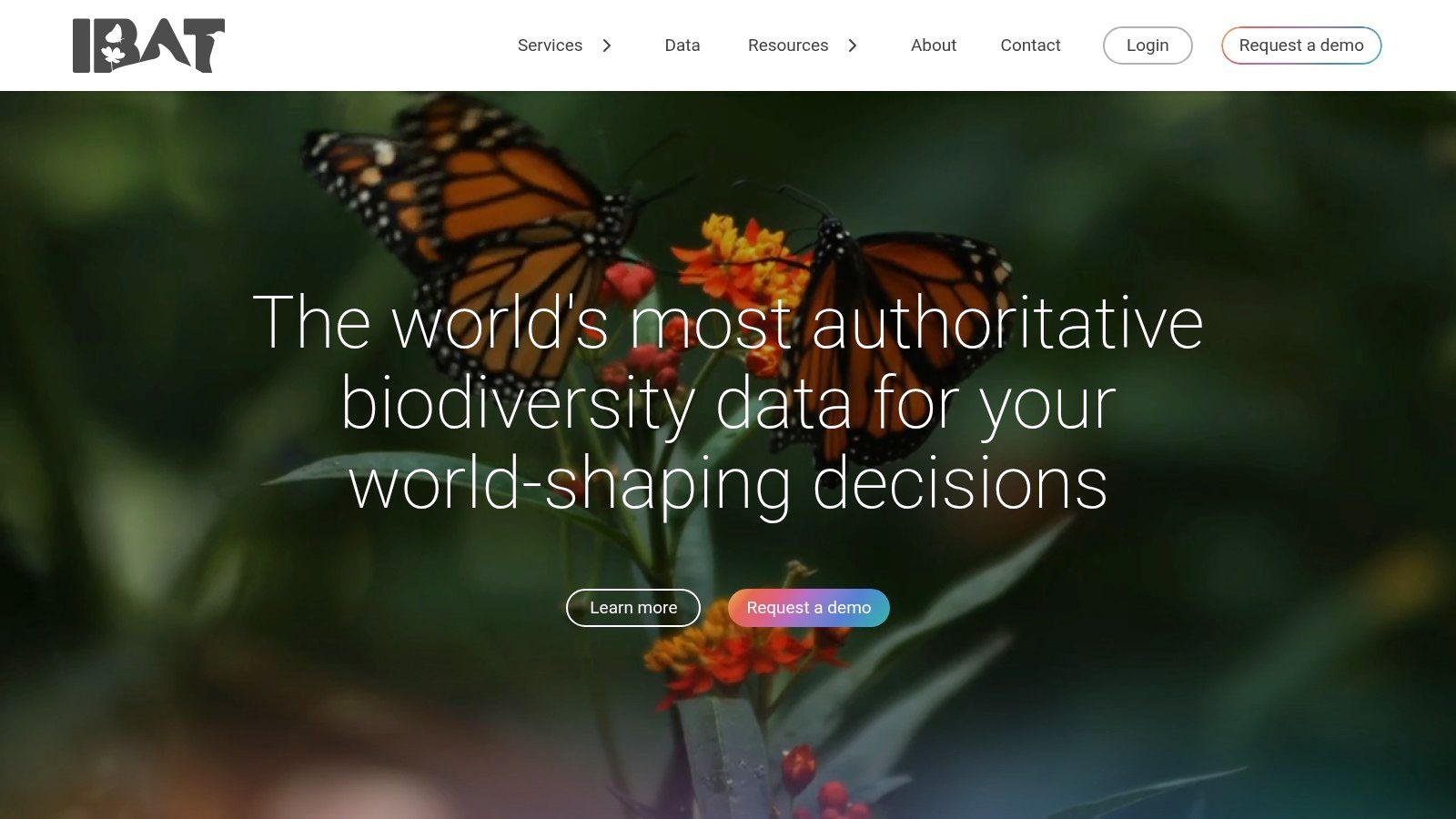
This tool is particularly powerful for the first stage of the Taskforce on Nature-related Financial Disclosures (TNFD) framework, the ‘Locate’ phase of the LEAP approach. Users can upload coordinates for a single site or a portfolio of assets to quickly identify proximity to protected areas, threatened species, and designated Key Biodiversity Areas. This initial screening provides the critical context needed before committing to more intensive, on-the-ground assessments.
Key Features & Use Case
- Core Function: Provides a high-level "red flag" analysis of biodiversity risks for specific geographic locations.
- Best For: Corporations performing initial due diligence, ESG analysts screening investment portfolios, and consultants conducting preliminary site assessments.
- Access: IBAT operates on a subscription model, with pricing tiered for different organisational sizes and usage levels. A free version for research and conservation purposes is also available.
IBAT stands out for its authority and simplicity. While it doesn't offer deep ecological modelling, its direct access to globally recognised datasets provides a defensible and standardised starting point for any corporate biodiversity strategy. It is one of the most widely used biodiversity impact reporting tools for risk identification.
Website: https://www.ibat-alliance.org
2. ENCORE (Exploring Natural Capital Opportunities, Risks and Exposure)
ENCORE is a powerful, free-to-use tool developed by the Natural Capital Finance Alliance, UNEP-WCMC, and UNEP FI. It is specifically designed to help financial institutions and corporations understand their relationship with nature. By mapping how economic sectors depend on and impact natural capital, it provides a crucial bridge between business operations and environmental consequences, making it a vital resource among biodiversity impact reporting tools.
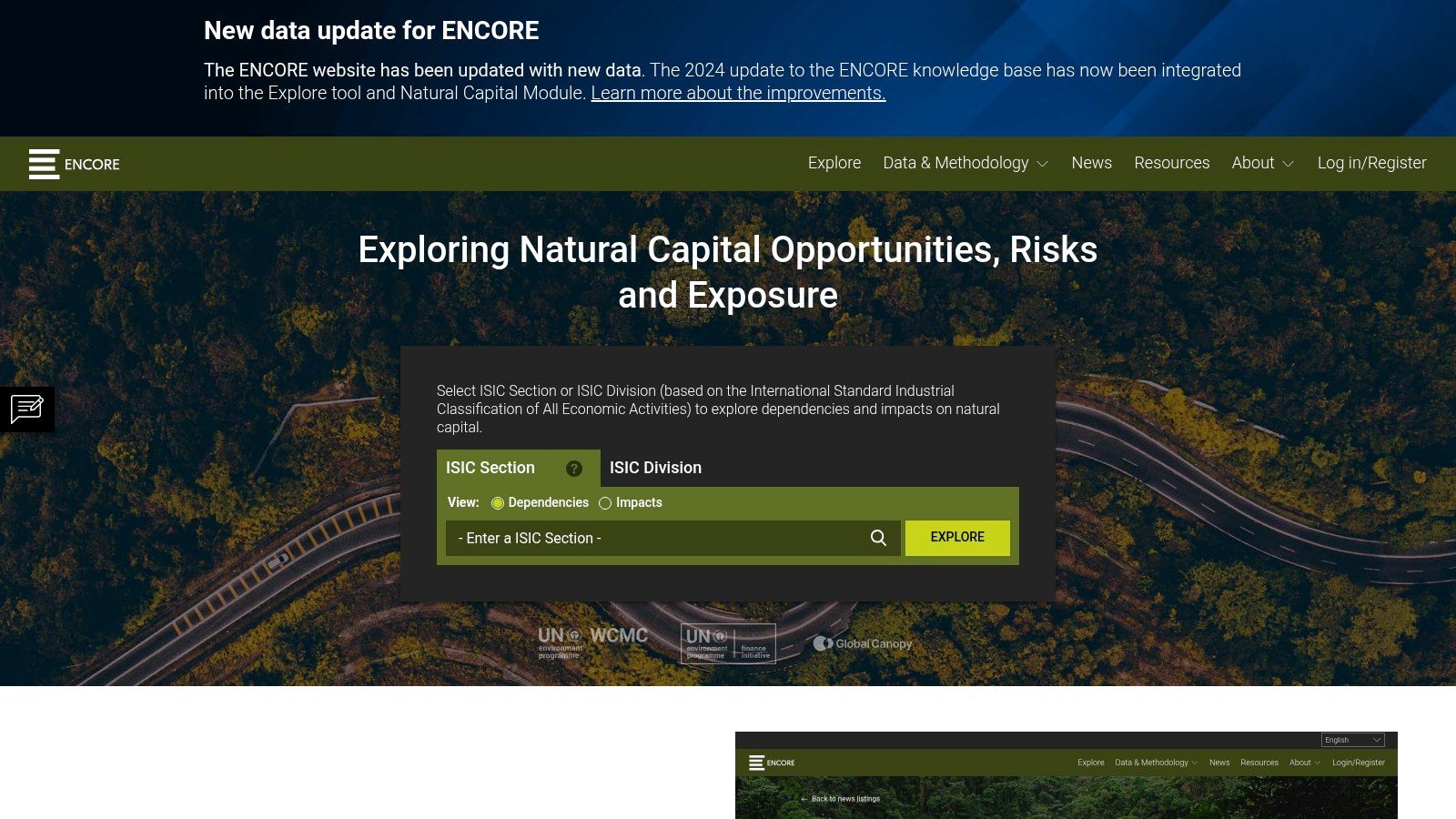
The platform is explicitly referenced in the TNFD’s LEAP guidance, particularly for the ‘Evaluate’ and ‘Assess’ phases. Its Biodiversity Module allows users to explore portfolio alignment with global biodiversity goals and identify hotspots where their financed activities are most likely to impact sensitive ecosystems. This sector-level analysis helps organisations prioritise which parts of their value chain or investment portfolio require a more detailed, asset-level investigation.
Key Features & Use Case
- Core Function: Provides a high-level mapping of sector dependencies and impacts on natural capital and biodiversity.
- Best For: Financial institutions screening portfolios, corporates identifying natural capital risks in their value chains, and sustainability teams conducting initial TNFD-aligned assessments.
- Access: The tool is completely free to use after a simple registration, offering full access to all its features and modules.
ENCORE excels at providing a standardised, top-down view of nature-related risks. While it doesn't offer granular, asset-specific quantification, its strength lies in its accessibility and direct alignment with financial sector needs and emerging disclosure frameworks.
Website: https://encorenature.org
3. One Click LCA – Biodiversity Supply Chain Stress Tool
One Click LCA extends its life cycle assessment capabilities to nature-related impacts with its Biodiversity Supply Chain Stress Tool. Specifically designed for the built environment sector, this module screens the biodiversity stress associated with construction materials and supply chains. It assesses impacts through indicators related to climate change, pollution, and resource use, providing a targeted analysis of upstream risks.
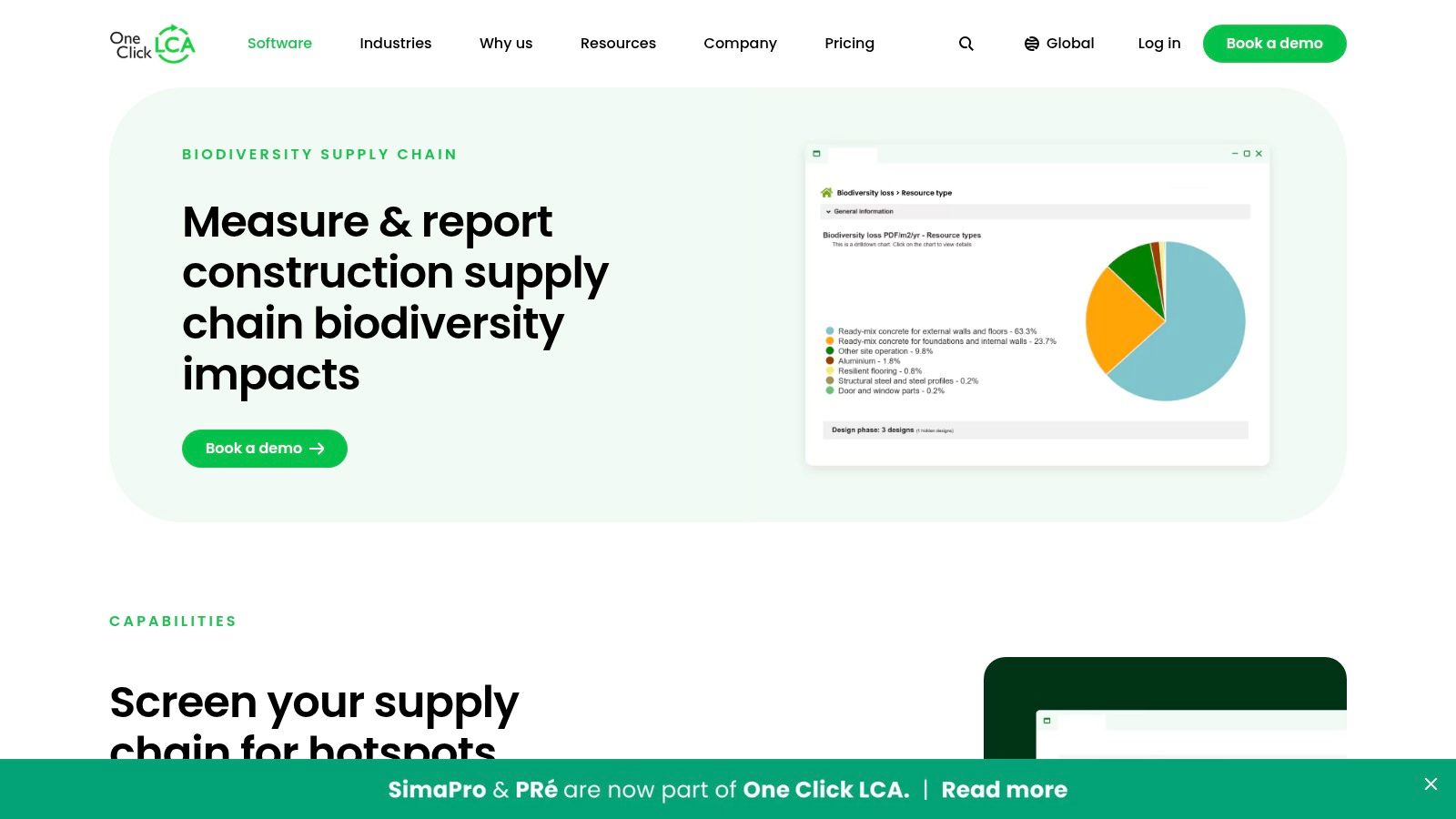
The tool is explicitly structured to support TNFD reporting, mapping its outputs directly to the 'Locate' and 'Evaluate' phases of the LEAP approach. This allows construction and real estate companies to integrate biodiversity considerations directly into their existing environmental assessment workflows. It pinpoints which materials or suppliers contribute most significantly to biodiversity stress, enabling more informed procurement and design decisions. This function makes it one of the more specialised biodiversity impact reporting tools available.
Key Features & Use Case
- Core Function: Identifies biodiversity stress hotspots within construction and product supply chains using LCA-based indicators.
- Best For: Sustainability managers in construction, real estate developers, and product manufacturers looking to integrate biodiversity into their LCA processes.
- Access: The tool is a module within the One Click LCA platform, available via enterprise licensing. Access is typically granted after a demonstration.
One Click LCA stands out by embedding biodiversity screening into the familiar LCA framework. While its focus on the built environment makes it less generalisable, it offers unparalleled integration for companies already using LCA for carbon and environmental reporting, streamlining the data collection and analysis process.
Website: https://oneclicklca.com/software/design-construction/biodiversity-supply-chain-stress-tool
4. SimaPro BioScope (by PRé Sustainability)
SimaPro BioScope offers a high-level entry point for organisations to understand their potential biodiversity impacts through the lens of economic activity. Developed by PRé Sustainability, it utilises economic input-output databases like Exiobase to estimate the land-use-related biodiversity footprint of purchased goods and services. This makes it an ideal tool for initial hotspot analysis within complex supply chains where site-specific data is not yet available.
The tool allows users to input spending data across 163 sectors in 44 countries to generate rapid, visual estimates of their impact. While not a substitute for a detailed Life Cycle Assessment (LCA), BioScope provides a crucial first step. It helps businesses prioritise which commodities, suppliers, or investment areas warrant a more granular, site-specific investigation, aligning well with the initial screening phases of frameworks like the TNFD.
Key Features & Use Case
- Core Function: Approximates biodiversity footprint based on monetary inputs and national-level economic data.
- Best For: Sustainability managers conducting initial supply chain hotspotting, financial institutions screening portfolios, and companies wanting a fast, preliminary overview of their land-use impacts.
- Access: BioScope is a free, web-based tool accessible to anyone, making it one of the most approachable biodiversity impact reporting tools for beginners.
BioScope stands out for its simplicity and accessibility. It effectively translates complex economic data into an initial biodiversity risk indicator without requiring deep technical expertise. Its main limitation is the lack of geographical specificity, but as a free scoping resource, it provides immense value for focusing subsequent, more detailed assessment efforts.
Website: https://simapro.com/products/bioscope/
5. ecoinvent
The ecoinvent database is the world's most consistent and transparent life cycle inventory (LCI) database. While not a standalone biodiversity tool, it provides the essential background data required to quantify biodiversity impacts within a Life Cycle Assessment (LCA). It contains extensive data on resource extraction, production processes, and emissions, which can be linked to biodiversity impact categories using methods like ReCiPe or IMPACT World+.
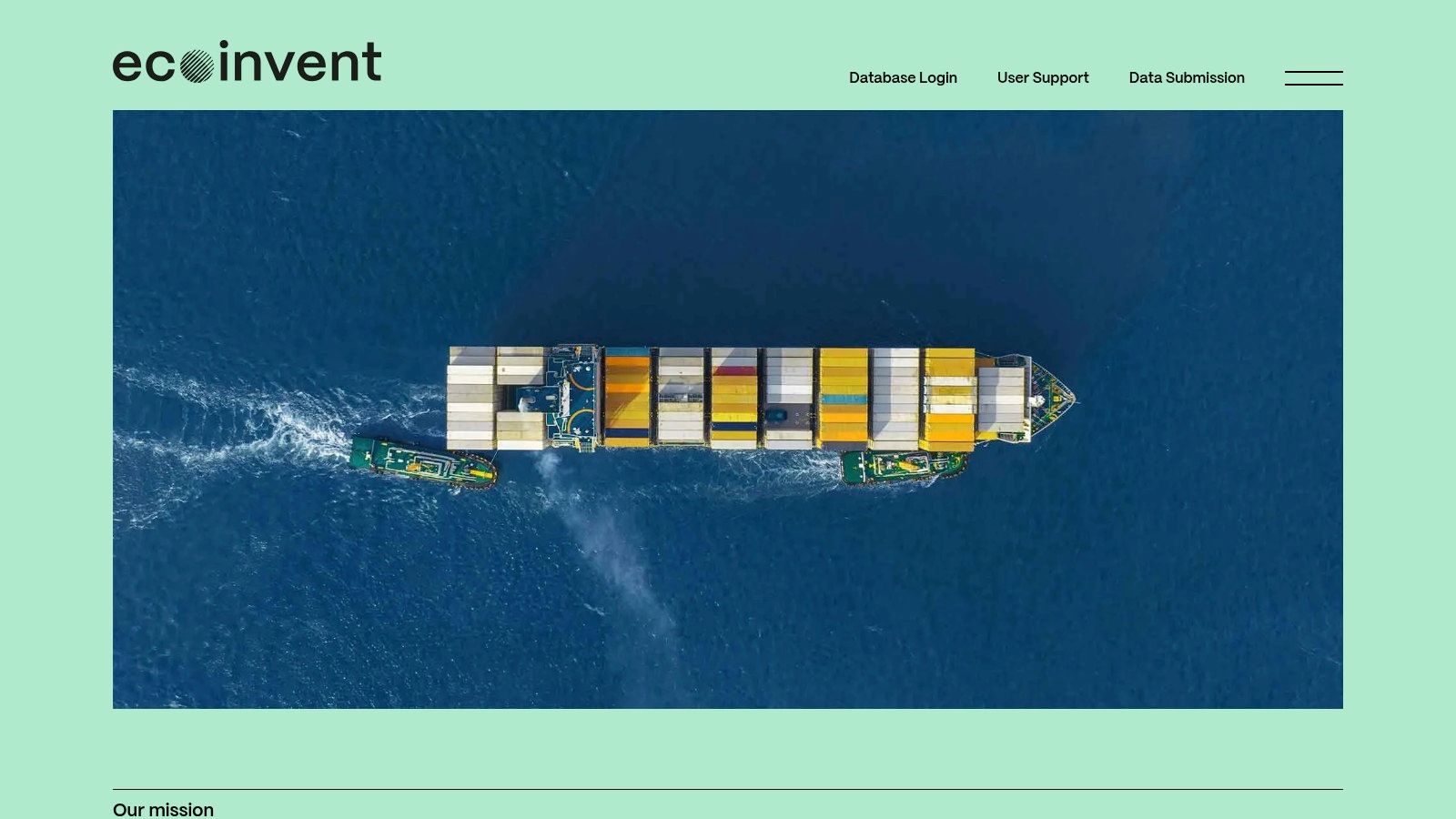
For organisations moving beyond risk screening into quantifying their supply chain's footprint, ecoinvent is indispensable. It allows professionals using software like SimaPro or openLCA to model their entire value chain and calculate potential impacts on land use, ecotoxicity, and other factors that directly affect ecosystems. This detailed analysis supports science-based target setting and granular hotspot identification, making it a powerful component of advanced biodiversity impact reporting tools.
Key Features & Use Case
- Core Function: Provides comprehensive LCI data for quantifying environmental impacts, including those related to biodiversity, through LCA software.
- Best For: Environmental consultants, LCA practitioners, and large enterprises aiming to measure the detailed biodiversity footprint of their products and supply chains.
- Access: ecoinvent is a commercial database available through annual subscription licences, with pricing dependent on the user type and number of licences.
ecoinvent stands out due to its global recognition as the industry standard for LCA data, ensuring credibility and comparability. While its use requires specialised LCA expertise and software, the depth and quality of its data are unmatched for detailed product and organisational footprinting.
Website: https://ecoinvent.org
6. openLCA + openLCA LCIA methods (GreenDelta)
openLCA is a powerful, open-source Life Cycle Assessment (LCA) software that provides a flexible framework for detailed environmental impact analysis. While not exclusively a biodiversity tool, its strength lies in its ability to integrate Life Cycle Impact Assessment (LCIA) methods like ReCiPe and IMPACT World+. These methods translate resource use and emissions into potential impacts on ecosystems and species, allowing users to calculate a sophisticated biodiversity footprint for products, services, or entire organisations.
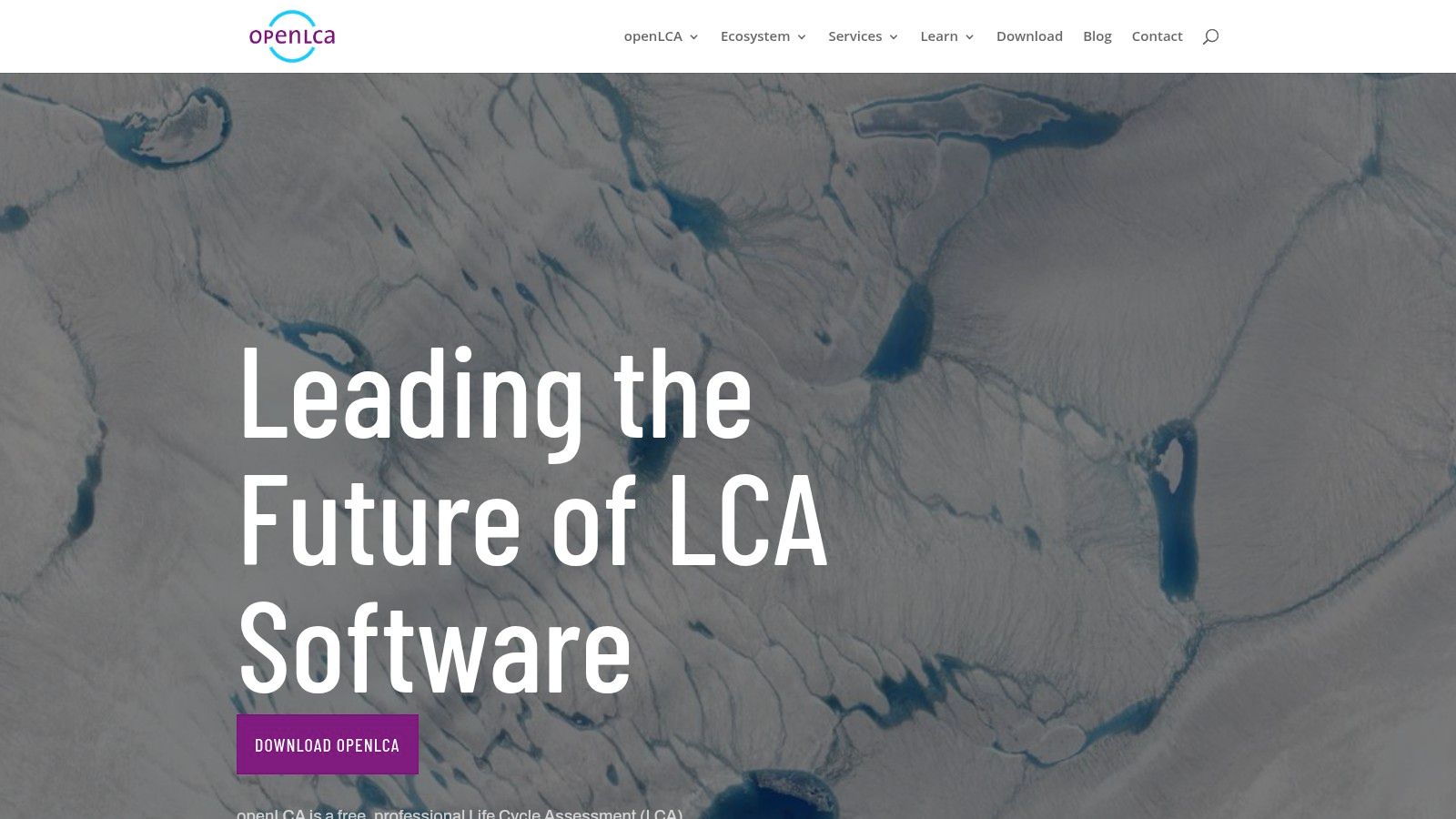
This platform is ideal for practitioners who need to move beyond high-level screening to conduct in-depth, customised assessments. By combining the free software with commercial databases, sustainability professionals can model complex value chains and identify specific drivers of biodiversity loss, such as land use change, ecotoxicity, and acidification. It is one of the more technical biodiversity impact reporting tools, offering unparalleled customisation for advanced LCA practitioners.
Key Features & Use Case
- Core Function: Performs detailed Life Cycle Assessments to quantify environmental impacts, including those relevant to biodiversity, using established scientific methods.
- Best For: Environmental consultants, sustainability analysts, and academic researchers requiring a granular, customisable tool for product footprinting and hotspot analysis.
- Access: The core openLCA software is free to download and use. Commercial datasets and specific LCIA method packs are available for purchase to extend its capabilities.
openLCA stands out for its customisability and low initial cost, making advanced LCA accessible. While it has a steeper learning curve than web-based platforms, its flexibility allows for a highly detailed and defensible analysis of environmental performance. For those interested in a deeper dive, you can explore more resources on how tools like openLCA are used to track environmental impact.
Website: https://www.openlca.org
7. IMPACT World+ (LCIA method)
IMPACT World+ is a globally regionalised life cycle impact assessment (LCIA) method rather than a standalone tool. It provides crucial characterisation factors that quantify potential ecosystem damage, which are essential for detailed biodiversity impact reporting within a Life Cycle Assessment (LCA) framework. The method is designed to be integrated into existing LCA software, enabling professionals to assess the biodiversity impacts of products and services across their entire value chain.
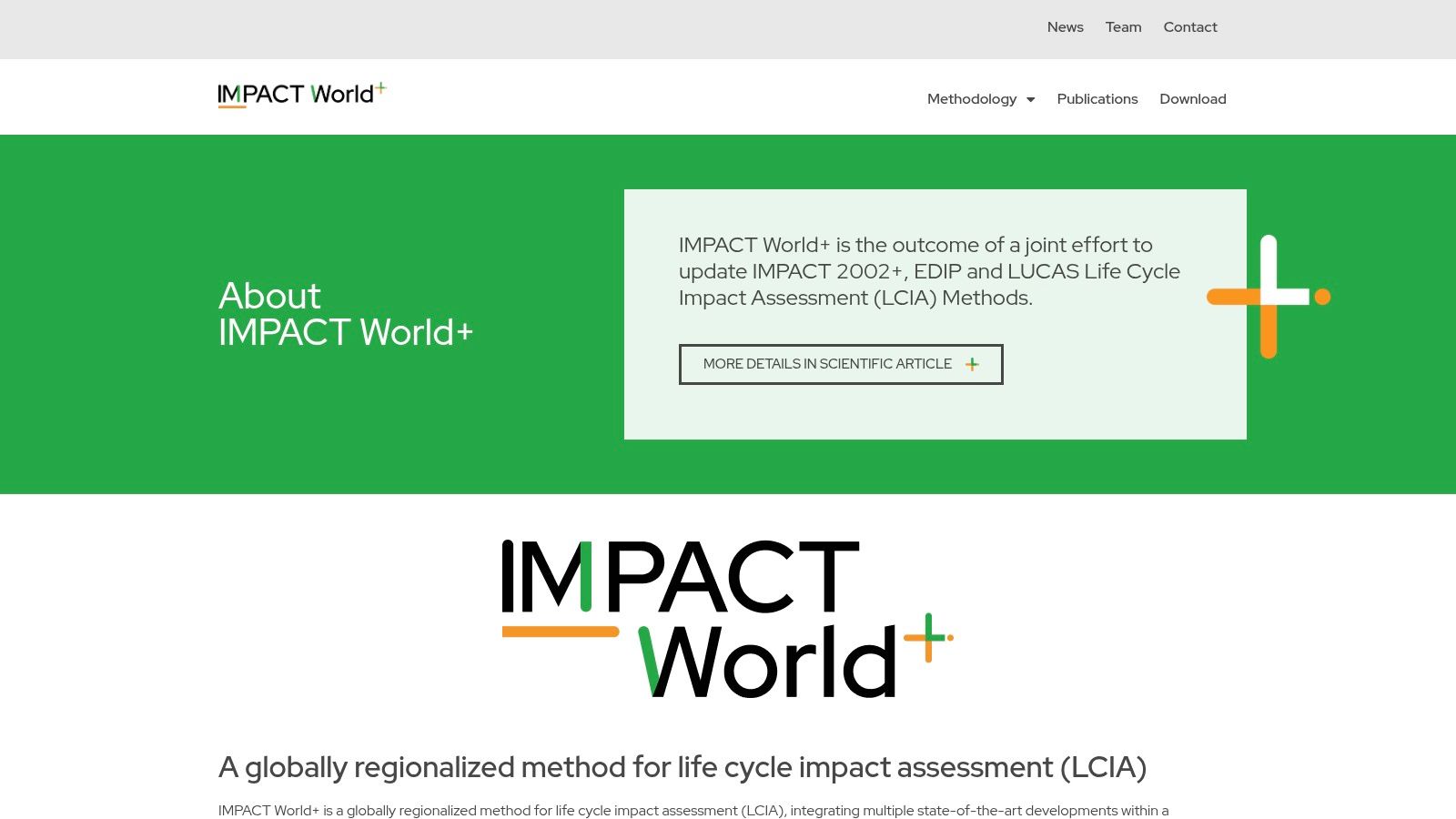
This method enhances the accuracy of biodiversity assessments by using spatially differentiated impact factors. This means the potential damage to ecosystems is calculated based on the specific region where an impact occurs, reflecting the varied vulnerability of different environments. It allows organisations to move beyond generic, global-average metrics and produce more geographically relevant and defensible biodiversity impact results, making it a powerful resource for advanced LCA practitioners.
Key Features & Use Case
- Core Function: Provides regionalised characterisation factors to quantify ecosystem quality impacts within LCA studies.
- Best For: LCA practitioners, environmental consultants, and corporate sustainability teams seeking to integrate detailed biodiversity metrics into product life cycle assessments.
- Access: The method packages and extensive documentation are available for free download, designed for integration with major LCA software like SimaPro and openLCA.
IMPACT World+ stands out by offering a scientifically robust and granular method for free. While it requires significant technical expertise and specialised software to implement, its research-backed approach provides a higher level of detail than many other biodiversity impact reporting tools, particularly for supply chain analysis.
Website: https://www.impactworldplus.org
8. TNFD (Taskforce on Nature-related Financial Disclosures)
The Taskforce on Nature-related Financial Disclosures (TNFD) provides the leading global framework for corporate nature reporting. Rather than being a data tool itself, it offers a comprehensive set of recommendations and guidance for how organisations should identify, assess, manage, and disclose their nature-related dependencies, impacts, risks, and opportunities. Its central LEAP approach (Locate, Evaluate, Assess, Prepare) provides a clear roadmap for businesses to follow.
The TNFD website is a crucial hub, housing the complete framework, implementation guides, and case studies. For sustainability and finance professionals, it is the primary source for understanding how to integrate nature into decision-making and reporting in a way that aligns with emerging regulations and investor expectations. It effectively acts as the 'rulebook' that many other biodiversity impact reporting tools are designed to support.
Key Features & Use Case
- Core Function: Provides a standardised framework and disclosure recommendations for corporate reporting on nature-related issues.
- Best For: Chief Sustainability Officers, ESG teams, and compliance professionals seeking to align their corporate strategy and reporting with global best practices.
- Access: All TNFD framework documents, guidance, and resources are available for free on their website.
The TNFD stands out by creating a market-led, standardised language for nature that mirrors the climate-focused TCFD. While it requires other tools for implementation, its strong alignment with developing standards like ESRS makes its adoption a strategic necessity for forward-thinking organisations.
Website: https://tnfd.global
9. Science Based Targets Network (SBTN)
The Science Based Targets Network (SBTN) provides a framework for companies to transition from assessment to action by setting measurable, time-bound targets for nature. It guides organisations on how to align their environmental goals with the planet's ecological limits, focusing initially on freshwater and land systems. SBTN's methodology helps translate broad biodiversity commitments into concrete corporate objectives.
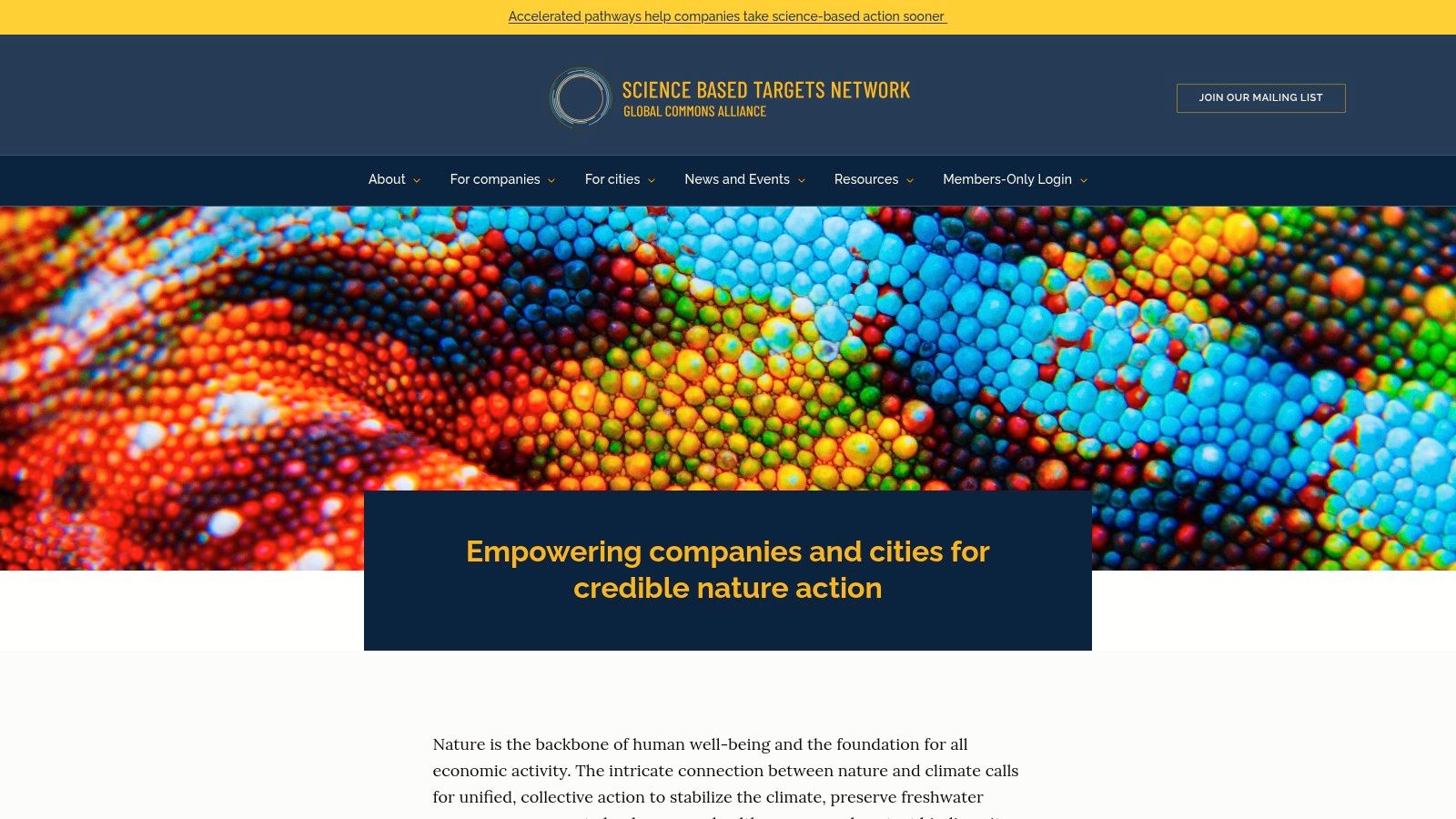
This framework is crucial for companies aiming to operationalise their findings from tools like IBAT or the TNFD's LEAP approach. After identifying and assessing impacts, SBTN offers the "Set a Target" and "Act" phases, creating a clear pathway to mitigate harm and contribute to nature-positive outcomes. Its strong alignment with the Global Biodiversity Framework (GBF) makes it a credible standard for investors and regulators monitoring corporate progress.
Key Features & Use Case
- Core Function: Offers a corporate manual and technical guidance for setting science-based targets for freshwater, land, and eventually oceans.
- Best For: Sustainability managers, ESG teams, and corporate strategists seeking to set credible, verifiable nature-related targets aligned with global goals.
- Access: All guidance, manuals, and resources are publicly available for free on the SBTN website.
SBTN stands out by providing the critical link between biodiversity risk assessment and credible target-setting. While its methodologies are still maturing and require significant internal capacity to implement, it is recognised as a leading framework among biodiversity impact reporting tools for ensuring corporate ambitions are scientifically robust.
Website: https://sciencebasedtargetsnetwork.org
10. CDP – Corporate Environmental Disclosure (nature/biodiversity)
CDP operates a global environmental disclosure system that allows organisations to report on their climate, water, forest, and increasingly, biodiversity impacts. Rather than a direct measurement tool, it provides a standardised framework and questionnaire for companies to report their nature-related risks, strategies, and performance. This makes it a crucial platform for investor-led accountability and corporate transparency on biodiversity.
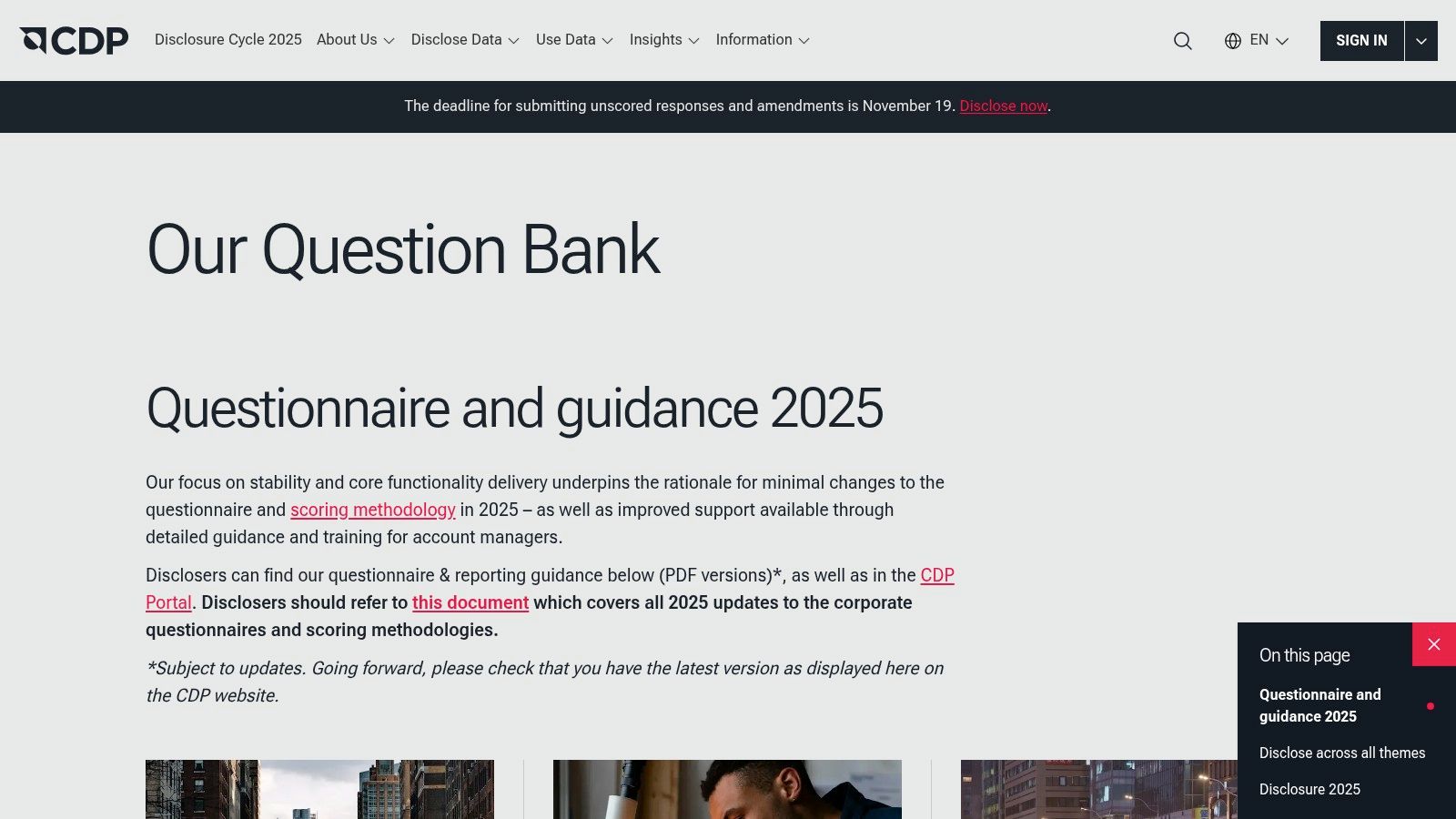
The platform is aligning its nature-related questions with frameworks like the TNFD, creating a unified reporting mechanism that capital markets recognise and trust. By responding to CDP's questionnaire, companies provide comparable data that investors use to benchmark performance and assess nature-related financial risks. It serves as a vital communication channel between corporations and their stakeholders on environmental stewardship, making it one of the most influential biodiversity impact reporting tools for public disclosure.
Key Features & Use Case
- Core Function: A structured disclosure system for companies to report environmental data, including biodiversity, to investors, purchasers, and other stakeholders.
- Best For: Publicly-listed companies responding to investor requests, organisations aiming to align with TNFD, and ESG teams managing corporate sustainability reporting.
- Access: The questionnaire and guidance are free to access, but companies may incur costs for responding, either through subscription fees or third-party support services.
CDP’s strength lies in its widespread adoption by the financial community, which incentivises thorough and credible corporate reporting. While the quality of the disclosure depends on the company's internal data, the standardised format provides a powerful mechanism for driving corporate action on nature loss. You can learn more about how CDP integrates into the wider landscape of top ESG reporting tools for businesses.
Website: https://www.cdp.net/disclose/question-bank
11. Trase
Trase is an open-access data platform that brings unprecedented transparency to commodity supply chains, directly linking them to deforestation and other environmental risks. It maps the journey of key commodities like soy, beef, and palm oil from their production locations to the countries of import. This makes it a critical tool for organisations looking to tackle biodiversity loss embedded deep within their supply chains, particularly for CSRD and TNFD reporting.
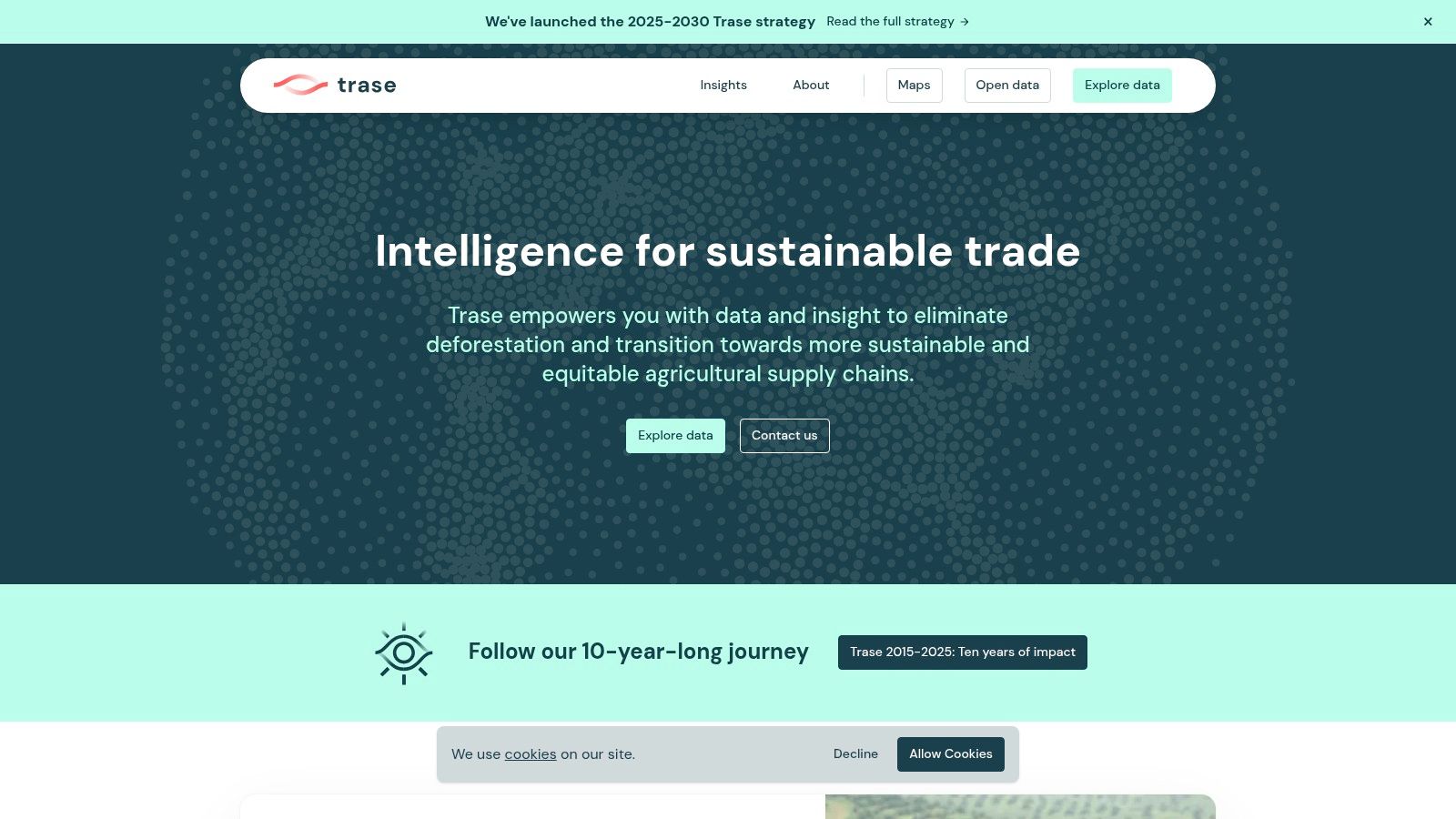
The platform empowers users to identify specific subnational regions and traders associated with high deforestation risk, providing the asset-level detail needed for robust due diligence. By connecting products to places, Trase allows companies to move beyond broad assumptions and pinpoint the precise hotspots in their sourcing networks. This granular insight is essential for effective engagement with suppliers and for developing targeted, credible strategies to mitigate nature-related impacts. A deeper understanding of this is crucial for mastering supply chain visibility for your business.
Key Features & Use Case
- Core Function: Maps commodity supply chains to reveal links between consumer markets, traders, and deforestation hotspots.
- Best For: Sustainability managers in the food and agriculture sectors, procurement teams conducting supplier due diligence, and financial institutions assessing portfolio risks.
- Access: Trase is a free, open-access platform. All its data, covering over 180 datasets, is downloadable for independent analysis.
Trase stands out by transforming complex supply chain data into actionable intelligence. While its focus on specific commodities means it isn't a universal solution, for companies exposed to these key deforestation drivers, it is one of the most powerful biodiversity impact reporting tools available for identifying and managing nature-related risks.
Website: https://trase.earth
12. AOPK ČR – ISOP (Czech Nature Conservation Agency Information System)
The Nature Conservation Agency of the Czech Republic (AOPK ČR) provides the ISOP, the country's official national biodiversity data portal. This platform is a critical resource for any organisation operating within the Czech Republic, offering authoritative data on species occurrence, protected areas like Natura 2000 sites, and other ecologically significant locations. It serves as a foundational data layer for site-specific biodiversity assessments and localised impact reporting.
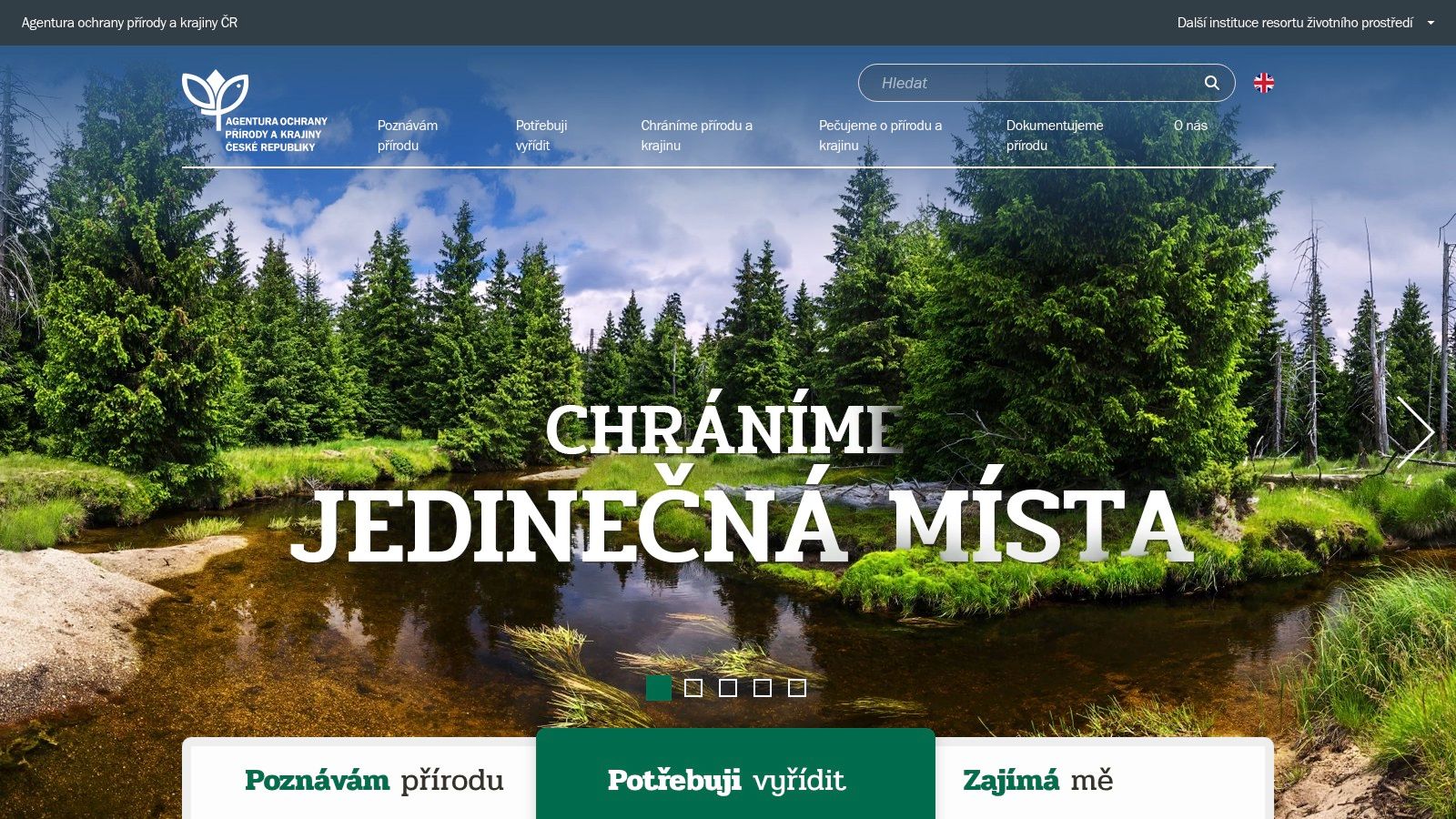
Unlike global aggregators, ISOP delivers granular, government-verified data essential for detailed project planning, environmental impact assessments (EIAs), and compliance with Czech and EU nature directives. Its public map applications and machine-readable data services allow for direct integration into corporate GIS systems, enabling precise analysis of a facility's or project's potential impact on local ecosystems. This makes it an indispensable tool for accurate, defensible reporting within a national context.
Key Features & Use Case
- Core Function: Provides free, high-resolution national biodiversity data for the Czech Republic, including species records and protected area boundaries.
- Best For: Companies conducting due diligence in the Czech Republic, environmental consultants preparing EIAs, and compliance managers aligning with local regulations.
- Access: The platform is largely open and free to use. However, the primary interface is in Czech, and access to certain sensitive data may require registration or specific permissions.
ISOP stands out for its authority and specificity. While its geographic scope is limited to one country, the depth and reliability of its data are unmatched for operations within the Czech Republic. It is a prime example of the national-level biodiversity impact reporting tools that are crucial for accurate, localised risk and impact analysis.
Website: https://www.aopk.cz
Biodiversity Impact Reporting Tools Comparison
| Tool/Platform | Core Features/Capabilities | User Experience & Quality ★ | Value Proposition 💰 | Target Audience 👥 | Unique Selling Points ✨ |
|---|---|---|---|---|---|
| Integrated Biodiversity Assessment Tool (IBAT) | Automated biodiversity risk reports, GIS data downloads, STAR metric visualization | ★★★★☆ High accuracy, enterprise APIs | Flexible pricing, free tier + pay-as-you-go | Corporates, ESG teams, large enterprises | Authoritative datasets, ready-made disclosure reports 🏆 |
| ENCORE | Nature dependency mapping, spatial hotspot explorer, TNFD LEAP support | ★★★☆☆ Easy access, free | Free access | Banks, financial sector | TNFD LEAP aligned, finance-focused |
| One Click LCA – Biodiversity Supply Chain Stress Tool | Supply chain biodiversity hotspot screening, LCA integration | ★★★☆☆ Demo-based, tailored documentation | Enterprise license, pricing undisclosed | Built environment, construction sector | LCA integration, TNFD LEAP guidance |
| SimaPro BioScope | Rapid screening via input-output databases, visual maps | ★★★☆☆ User-friendly, well documented | Free tool | Initial biodiversity screeners, analysts | Free, fast scoping tool, broad country coverage |
| ecoinvent | Comprehensive LCA inventory data, multiple system models | ★★★★★ Industry standard, robust data | Commercial license | LCA experts, sustainability professionals | Extensive datasets, strong documentation 🏆 |
| openLCA + openLCA LCIA methods | Free LCA software, purchasable datasets and methods | ★★★★☆ Flexible, strong community | Low entry cost, additional data cost | LCA practitioners, advanced users | Custom biodiversity footprints, extensible |
| IMPACT World+ (LCIA method) | Regionalized biodiversity impact factors, free method files | ★★★★☆ Research-backed, granular regionalization | Free method files | LCA users, biodiversity modelers | Spatially differentiated LCIA factors ✨ |
| TNFD | Framework & guidance for nature-related risk disclosure | ★★★★☆ Comprehensive, globally recognized | Free guidance | Corporates, financial sector | De facto biodiversity reporting standard 🏆 |
| Science Based Targets Network (SBTN) | Nature science-based target guidance, sector pilots | ★★★★☆ Clear target-setting pathway | Free guidance | Corporates, sustainability planners | Aligns biodiversity & water targets, investor recognized |
| CDP – Corporate Environmental Disclosure | Biodiversity & environmental disclosure questionnaire, scoring | ★★★★☆ Investor relevant, detailed | Free access; possible subscription | Corporates, investors | High comparability, market visibility 🏆 |
| Trase | Supply chain mapping for commodities, subnational biodiversity risk data | ★★★☆☆ Open access, data intensive | Free platform | Supply chain managers, sustainability teams | Commodity-focused datasets, subnational insights |
| AOPK ČR – ISOP | National biodiversity data, protected area registries, APIs | ★★★☆☆ Authoritative, Czech language | Mostly free access | Local authorities, researchers | National-level accurate data, INSPIRE harmonized |
Building Your Integrated Biodiversity Reporting Toolkit
Navigating the landscape of biodiversity impact reporting tools can feel daunting, but the journey towards meaningful nature-positive action is not about finding a single, silver-bullet solution. As we have explored, the most effective approach involves assembling a strategic, integrated toolkit tailored to your organisation's unique operational footprint, supply chain complexity, and strategic objectives. This means moving away from a one-size-fits-all mindset and towards a layered, multi-tool strategy that provides a comprehensive view of your dependencies and impacts on nature.
The key takeaway is that different tools serve distinct, yet complementary, purposes. Your strategy should reflect a clear progression from broad-based screening to granular, site-specific analysis and, finally, to transparent disclosure. A logical starting point for many organisations is using high-level screening tools like ENCORE to identify potential nature-related risks and opportunities across business sectors and geographies. This initial assessment helps to prioritise areas for deeper investigation.
From Screening to Quantification and Disclosure
Once hotspots are identified, the next step involves more detailed analysis. Tools like the Integrated Biodiversity Assessment Tool (IBAT) and regional databases such as the AOPK ČR's ISOP provide critical, site-specific data on protected areas and species of concern. This allows you to understand the direct, localised impact of your operations. For a comprehensive, product-level understanding, a robust Life Cycle Assessment (LCA) is indispensable. This is where combining platforms like openLCA or SimaPro with extensive databases like ecoinvent and sophisticated impact assessment methods like IMPACT World+ becomes essential for quantifying your footprint across the entire value chain.
Ultimately, the data and insights generated by these technical tools must feed into your strategic decision-making and corporate reporting. This is where frameworks and disclosure platforms play their crucial role. The Taskforce on Nature-related Financial Disclosures (TNFD) provides the framework for assessing and reporting on nature-related risks, while the Science Based Targets Network (SBTN) helps you set credible, science-aligned goals. Finally, disclosing this information through established platforms like CDP ensures transparency and accountability with stakeholders, investors, and customers.
Charting Your Course for Nature-Positive Action
Selecting the right combination of biodiversity impact reporting tools requires a clear understanding of your organisation's specific needs. Consider these factors:
- Your Industry and Value Chain: A company with a complex agricultural supply chain (using Trase) will have different needs than a financial institution (using ENCORE).
- Organisational Maturity: Are you just beginning your biodiversity journey or are you ready for advanced quantitative modelling with LCA tools?
- Reporting Requirements: Which frameworks and regulations (e.g., CSRD, TNFD) are most relevant to your business and stakeholders?
By carefully layering these platforms-from high-level screening and deep LCA analysis to strategic goal-setting and disclosure-you build a robust system. This integrated approach empowers your organisation to move beyond mere compliance, enabling you to manage risks effectively, uncover new opportunities, and build genuine ecological resilience into the core of your business model. The path forward is one of integration, precision, and transparency.
Navigating the complexities of data integration across these diverse tools can be a significant challenge. For organisations looking to streamline their sustainability data management and reporting, Carbonpunk offers a centralised platform to consolidate environmental metrics, manage compliance, and simplify the disclosure process. Discover how to build a unified data foundation for your biodiversity strategy at Carbonpunk.